|
HOW IT ALL BEGAN:
Friday 7th of January 1966. The 1st
Battalion of the 28th Infantry, itself part of the 3rd Brigade of the
1st Inf Div - "The Big Red One"- was engaged in operation
"Crimp". The first search and destroy sweep into the VC held
area's Northwest of Saigon. Operation "Crimp" was intended to
be a massive strike against the VC in South Vietnam; in and around the
Ho Bo woods just west of the Iron triangle.
Even as the men from the 1st Batt 28th
Inf touched down on LZ (landing zone) "Jack" they could see
their comrades in the 1st Batt 16th Inf were already in trouble and
engaging the enemy in small fire fights. The men quickly de-assed their
helicopters and moved into the nearby tree line hoping to find, engage,
and destroy the VC that had been harassing the soldiers of the 16th Inf.
Just inside the tree line at the edge
of a rubber plantation, the men of the 28th discovered a large trench -
but no enemy. Where had they gone? How could the VC who had been firing
at the men of the 16th Inf just disappear apparently into thin air? As
the Batt moved forward it began to find large caches of rice, and enough
food to feed a Regiment. As the operation continued, over the next
couple of days foxholes, trenches, and caves were discovered. Still no
enemy were being engaged in running fire fights, or surrendering, and all
the time US casualties were mounting through sustained enemy sniper
fire.
By the 10th of January the 28th had
reached the banks of the Saigon river. So far during the 3 days of the
operation only a couple of brief glimpses of the enemy had been seen.
Late in the afternoon of the 10th word came through via the radio that
elements of the 173rd Airborne
Brigade and
the Aussies to the north had made
contact with the VC and - found tunnels.
|
1st
Battalion, Royal Australian Regiment, left South Vietnam, having
completed almost a full year of combat duty. In leaving, the
"diggers" could point with pride to a creditable
performance during their stay, highlighted by participation
in no fewer than nineteen major operations.
Of particular note was an operation conducted in January 1966
which resulted in one of the biggest
intelligence coups of the war
up to that time. During a sweep of the so-called Iron Triangle, an
area near Saigon heavily fortified and controlled by the Viet
Cong, the Australian unit
discovered a vast complex of tunnels, dug 60 feet deep in some
places, which turned out to
be a Viet Cong headquarters. In addition to capturing five new
Chinese Communist anti-aircraft guns, the Australians
discovered 6,000 documents,
many revealing names and locations of Viet Cong agents. (from
American Report) |
|
The next day the 11th of January the 28th began to retrace it's foot
steps. It had finally dawned on the Battalion Commander LTC Robert Haldane
what had happened - they had literally walked right over the VC!
Searches were begun for the tunnel entrances but nothing much was
discovered. By now hot and tired, and waiting for further instructions
some of the GIs began to sit down for a quick rest.
Sergeant Stewart
Green did the same, but only momentarily, as he suddenly leap to his
feet cursing that something had bitten him on the ass. Thinking he'd
been stung by a scorpion, or worse, bitten by a snake, Green searched
through the layer of dead leaves that covered the area looking for the
creature that bitten him. Only to discover it was a nail sticking up
from the ground. Upon further careful inspection it was discovered that
the nail was part of a small wooden trap door - Haldane's men had found
their first tunnel!
THE TUNNEL SYSTEM:
Originally the tunnels were started
during the war against the French, but which were rapidly expanded upon
when the American's arrived. They were constructed by volunteer(!)
village labourers using simple hoe's and baskets. The Laterite clay in
which the tunnels were dug has a dull reddish appearance and dries rock
hard during the dry season. During the wet season it is very soft and
much easier to work. Because of the very nature of the Laterite clay's
ability to dry rock hard it made a very good (if a somewhat difficult
substance to work) soil in which to carve out a tunnel.
The passages
themselves were not cut in dead straight lines, rather they were made
with corners that had between a 60 - degree and a 120 - degree angle to
them. In other words the corners were constructed with no less than a 60
- degree angle and no more than a 120 - degree angle. This made shooting
in a straight line impossible, and helped to deflect explosive blasts
from grenades that might be thrown down.
The tunnel systems (where the water
table permitted) had several levels, each level was separated by a
watertight trap door which would seal the rest of the system against
gas, flooding, etc. The trap doors themselves were virtually
undetectable and could fool a person into believing that the tunnel
finished in a dead end, when in reality it led into a huge system of
other passages. These passages would in turn lead to underground ammo
dumps, kitchens, air raid shelters, hospitals, store rooms, workshops,
latrines, and even theatres for the performances of political plays.
All the tunnel systems had smaller thin (drain pipe sized) ventilation
shafts leading from the surface down to the 1st level. These vents were
constructed with an oblique angle so as to prevent the monsoon rains
flooding the system. Vents were placed so as to face east and the light
of a new day, whilst others were placed toward the wind so as to provide
a constant cooling draught. Despite these efforts the tunnels were still
hot, dark, and claustrophobic, even at the best of times.
The VC also dragged the bodies of
their dead comrades underground in order to inter them in temporary graves
when it became impossible to bury them above ground due to the presence
of American/Australian troops. Once they had been dragged underground they were
buried in the foetus position in the tunnel walls and covered with a thin
layer of clay.
THE OP ENGINEER (Tunnel
Rat)
(an underground man)
The leading scout raised his arm in the
village of Long Phuoc
He'd found another tunnel, but who'd go down to look?
The corporal passed the word back, it went back far behind
To let his platoon commander know of his recent find
Then along came this soldier, with mud from head to toe
"Where's the tunnel entrance?" was all he wanted to
know
When they showed the soldier, he quickly looked around
And before you could stop him, he'd gone underground
Now he'd been searching on his gut, all that day I bet
Look out for booby traps that good ol' Charlie sets
Then he found the wire, stretched out taut and thin
But he deloused that booby trap, with a safety pin
Then he found the weapons leaning on the wall
There was no disputing he'd found a real big haul
When he finally surfaced, wearing a big grin
He proudly showed the Diggers what he'd found within
Now he'd like to sit down, and roll himself a smoke
But he's been called up forward, by another bloke
So when you see that hat badge, that's like a bursting shell
Remember that this fellow has crawled half way through to hell
And if he's in a bar mate, you buy that bloke a beer
Because Sir, you're drinking with an Aussie Engineer
|
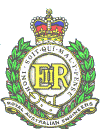 |
A SPECIAL BREED OF MAN:
Originally called "Tunnel
Runners" by the 25th Inf Div, and "Ferrets" by the
Australian Army, the term "Tunnel Rat" soon became their
official accepted name. The US Army soon realized that trying to destroy
the tunnels was a short-sighted policy that wasn't going to work.
Moreover this was also a loss as the underground networks could yield
vital intelligence on the VC in the form of plans and documents.
A chemical officer of the 1st Inf Div, Capt Herbert Thornton a Southerner, was charged with setting up the
first tunnel team.
The kind of man that Thornton sought
for his tunnel team had to be a special breed. He had to have an even
temperament, an inquisitive mind, a lot of common sense (in order to
know what to touch and what not to), and to be exceptionally brave.
All of Thornton's men were volunteers,
most (not all) were small men of slight build who could squeeze through
the tight trap doors and crawl along the narrow passages with relative
ease.
- No dead tunnel rats were left in a tunnel, dead or wounded they
were all dragged out with commo wire, ropes, or by a comrade using a
fireman's crawl.
It was a very stressful, nerve racking job, pushing the
rat's mental state to its limits. Crawling through narrow, pitch black
tunnels, sometimes for hours looking for a heavily armed enemy who would
if he got the drop on you not hesitate to kill you. Occasionally under
the strain a mans nerves would break and he'd be dragged from the tunnel
screaming and crying. Once this happened he would never be allowed down
a tunnel again.
If going down into a tunnel posed a
threat, then coming up again could be just as dangerous. Upon emerging
from a tunnel a rat would often whistle "Dixie" just to let
the troops on the surface know he was on their side. A little guy
stripped to the waist and covered in dirt could easily be mistaken
(particularly if he was oriental looking) for a VC and shot by his own
side.
TRAPS AND CREEPY CRAWLIES:
Going down into a tunnel system was a
very risky business fraught with danger. Usually armed only with a
pistol or a knife and a flashlight. The tunnel rat would descend into a
pitch black, claustrophobic, dank hell, to play a deadly game of hide
and seek with the enemy. Carefully probing the floor, sides and roofs of
the tunnels became second nature to the tunnel rat as he gently inched
and probed his way along. Feeling for wires or tree roots that didn't
quite feel right, knowing that anyone of them could detonate a booby
trap and blow him to smithereens.
Tunnel entrances were sometimes mined
or covered by concealed firing positions. On other occasions an entrance
would drop into a punji stake pit which would be covered by two rifle
men, one either side. Another way in which the unsuspecting tunnel rat
could meet his death was by garrotting him or cutting his throat as he
came up through a connecting trapdoor. Besides the booby traps the
tunnels also held other nasty surprises. Living along side the VC was a
whole plethora of animals which had also made their homes in the dark
confines of the tunnels. Bats
(the cave dwelling nectar eating bat and the black bearded tomb bat)
would use the tunnels as a roosting ground during the daylight hours.
A
tunnel rat crawling through a tight tunnel would wake them from their
rest causing them to fly right at him, getting tangled in his hair and
running and crawling all over him. Snakes were also encountered
underground. Two of the most deadly being the bamboo viper and the
Krait. Sometimes the VC would deliberately tether a snake in a tunnel to
use it as a sort of natural booby trap.
Scorpions
were also used as booby traps, the VC would take boxes of them into the
tunnels. The box would be rigged with a trip wire, the tunnel rat
tripped the wire and the scorpions would fall on him stinging him in the
process. Being stripped to the waist and slowly crawling along on their
stomachs also exposed the rats to bites from fire ants that inhabited
the underground labyrinths. Other nasties to be encountered in the
tunnels were real rats, and spiders like the Giant Crab Spider.
Sometimes whole chambers were crawling with a thick black mass of tiny
spiders the size of a thumb nail, giving the illusion that the walls
were moving!
TOOLS OF THEIR TRADE:
It was soon discovered early on that
to fight in the tunnels the tunnel rat had to do away with most of the
infantry mans basic load. In fact the total lack of equipment carried by
a rat was a distinct advantage, which greatly increased his chances of
survival. The basic tools of the tunnel rat were the knife, the pistol,
and a flashlight.
|
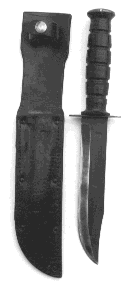
|
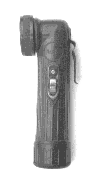
|
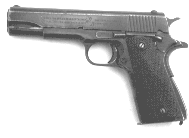
|
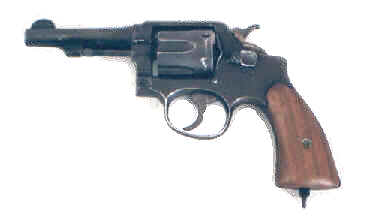 |
|
Knife of type that would be carried
|
Flashlight
|
Colt .45 Auto
Smith & Wesson .38
|
The
pistols that were carried by the tunnel rats were varied, the .38 Smith
and Wesson was a favourite. Other tunnel rats procured their own personal
firearms to suit their own needs. One of these was Master Sgt Flo Rivera
who acquired and used a 9mm German Luger. The one weapon everyone agreed
about was the Colt .45. It was too big, with a silencer it was to
cumbersome and when it was fired underground without a silencer its bark
was deafening. Making it impossible to hear the enemy.
One of the tunnel rats golden rules
was you never fired more than 3 shots underground without reloading, as
the VC would know you were out of ammo.
The flashlight was the standard Army
issue type and every rat carried one. These were carried in a way so as
not to make themselves a nicely illuminated target. If the bulb in the
flashlight went it had to be changed. This was practiced so it could be
done in pitch darkness by touch alone, and done quickly, lying prone,
squatting, or kneeling down.
|
Bunker Bomb.
These were made from an ammo
can which had a hole drilled in one end. A phosphorus grenade
was then taken and unscrewed, the main body of the grenade was
placed inside the can. The grenade lever is straightened and
fuse is then passed through the drilled hole and screwed back
onto the body. Finally the can is filled with napalm or
thickened fuel.
|
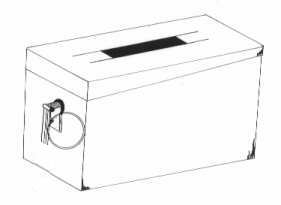
|
THE TUNNEL EXPLORATION KIT:
Due to the specialised nature of
tunnel warfare, priority was placed with ENSURE (Expedited Non-standard
Urgent Requirements for Equipment) program for the development of
special "Tunnel Exploration kits". Six kits were requested by
USARV on the 29th of April 1966, and then passed on to ACTIV (Army
Concept Team In Vietnam) on the 7th of August. ACTIV then distributed
the six kits, two went to the 1st Inf Div at Di An, a further two were
dispatched to the 25th Inf Div at Cu Chi. Of the remaining kits one was
given to the 1st Cav at An Khe, whilst the last remaining kit went to
the 173rd Airborne Bde at Bien Hoa.
Each kit cost 728 Dollars and consisted of a .38 calibre pistol which
was fitted with a suppressor and a spotlight sighting device. This was
all carried on a standard pistol belt in a specially designed holster.
On the wearers head was a baseball cap which had a miners lamp mounted
on it which was switched on and off via a mouth operated bite-switch. At
the back of the cap was a bone conduction microphone communication
system which was connected to a small ear piece. The power pack for the
lamp and a communication wire reel were also hung on the pistol belt,
but were situated on the wearers back.
Tests on the exploration kit in
Vietnam soon revealed its short comings. The silenced .38 cal pistol was
not liked because of its length with the suppressor, and because it
lacked balance and was awkward to handle. The special aiming light was
found to be unnecessary given the tight confines and short ranges the
tunnel rats were operating in. The huge pistol holster was also a
failure as it was too big and unwieldy to be used in the tight confines
of a tunnel. The head mounted miners lamp fared no better! This was
obstructed by the baseball cap's visor and could be shorted out by
switch malfunctions rendering it useless. Furthermore the lamp tended to
slip down over the wearers eyes. The earpiece part of the communication
system was also troublesome as it kept falling out of the wearers ear!
USARV requested 250 tunnel kits on the
21st of March 1967, but because of a mix up in the ordering quantity
(500 instead of the original 250) and year end budget problems,
immediate funding was slow in coming. Natick labs were not asked to
produce the sets until the 30th of September, this situation was further
frustrated by problems in the communication equipment for the kits.
Eventually the requested 250 sets were delivered to Dover AFB between
the 22nd and the 29th of May 1968, and from there immediately
flown to Vietnam.
With their patch with it's nonsense Latin
motto "Non gratum anus rodentum - Not worth a rats ass"
the tunnel rats were among the bravest in Vietnam, doing a job that not
many others could, or would care to do.
partly from
http://www.diddybop.demon.co.uk/tunnel1.htm |